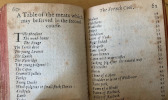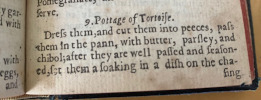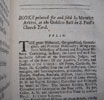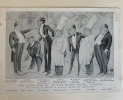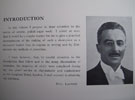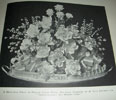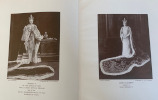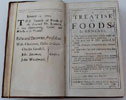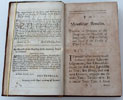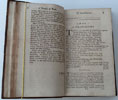The Modern Cook:
CONTAINING INSTRUCTIONS For Preparing and Odering Publick Enter-tainments for the Tables of Princes, Am-bassadors, Noblemen, and Magistrates. As also the least Expensive Methods of providing for private Families, in a very elegant Manner. New Receipts for Dressing of Meat, Fowl, and Fish, and making Ragouts, Fricassees, and Pastry of all Sorts, in a Method never before Publish'd. Adorn'd with COPPER PLATES, Exhibiting the Order of Placing the different Dishes, etc. on the Table, in the most polite Way. By Mr. VINCENT LA CHAPELLE, Late Cheif Cook to his Highness the Prince of ORANGE. The Third Edition. LONDON: Printed for Thomas Osborne, in Gray's-Inn. MDCCXLIV.
Third edition. Complete. 2feps. Title page. Dedication on verso. p 1-IV. p IX-XL. The Contents. 1-432. Illustrations. 6 letterpress folding plates of bills of fare and elaborate table settings. 2feps. A nice contemporary full dark brown calf binding with raised bands on the spine. A red and green label with gilt lettering. Gilt lines on the spine and boards. Internally very clean throughout. A beautiful copy, with one of the folding plates measuring an unusual eighteen inches long.
- Vincent La Chapelle, French Master cook to Phillip Dormer Stanhope, 4th Earl of Chesterfield, then William IV, Prince of Orange, after to Madame de Pompadour the mistress of Louis XV. When Chesterfield was sent to the Hague as Ambassador to arrange the marriage of William of Orange to Anne, daughter of George 11, he took La Chapelle with him. After Chesterfield returned to London, La Chapelle stayed behind and entered the service of William of Orange, to whom his books are dedicated. (Mossiman pub. Collection). Cagle has a 3rd edition of 3 volumes, dated 1736, with 16 folding plates.-- Maclean also has third editions of 1736 and 1744, both 3 volumes, a 4th edition of 1751 in 1 volume, but annoyingly, no mention of plates. -- Bitting has the 1st edition of 1733 in 3 volumes with 16 folding plates. She also has the 4th of 1751 with 6 folding plates. -- Oxford gives the 1st of 1733 in 2 volumes, the 2nd in 3 volumes and the 3rd of 1744 and a 4th of 1751, both 1 volume only, with no plates noted - urgh!. Oxford states: "This seems a most excellent and well arranged book, though some of the recipes are very strange. A 'strengthening broth' is made of two hundred sparrows with other ingredients. For besieged towns the author gives a recipe for 'broth cakes' which may be carried about, and 'preserv'd above a year'. The broth cakes are obviously a precursor to the modern day stock cubes. Vincent La Chapelle is now known to have been a little creative with the truth regarding his employment record and other issues. Maclean on p85. raises these points and also mentions Philip and Mary Hyman's very good article in Petits Propos Culinaires vol 2, pp 44-45, highlighting La Chapelle's famous spat with Massialot. Whatever claims of plagiarism between these two famous Chefs, this is nevertheless a great cookbook. Uniquely, La Chapelle published this work first in English in 1733 and then brought out the first French edition (Le Cuisinier Moderne) in 4 volumes in 1735. A 2nd French edition followed in 1742 with a new volume added. All complete copies or sets of La Chapelle's cookery books are extremely scarce.



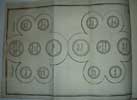

click on image to enlarge

Antiquarian category
ref number:
10982 


